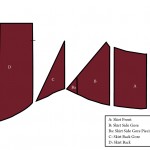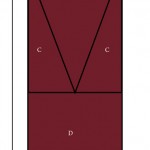Skirts! Skirts can be what makes or breaks a costume.
Too little and it looks odd, too much and you spend hours on end trying to pleat it down to size.
As skirts take up the most fabric I decided to cut them first, knowing I could squeeze the bodice and sleeves from the off cuts if I didn’t have enough fabric.
I knew the skirt of Eleanora’s funeral gown had a very similar cut to the Pisa gown.
I was going to use that as a base for mine, however a few days after I started planning a link to the poster from the Costume Colloquium in Florence that happened in 2008 was posted on livejournal.

It is a PDF file which you can find here.
In it, along with photos of the dress and some detail images, was a very small section of line art devoted to the stages of restoration the gown went through.
Save for some different piecing the skirt is the same shape as the funeral dress.
Knowing this I decided to make up a rough cutting diagram, so I’d have a general idea of how much fabric the skirts would take.

I have six yards of velvet 45″ wide.
I know Eleanora’s funeral gown was made up of 22″ panels of silk, and most of the velvets in the 16th century were also 22″. So despite having no measurements on the diagram I decided the Pisa dress was also made up of 22″ panels.
I took my waist to floor measurement + seam allowances + 1″ for the hem tuck + few inches extra as a just in case. (Accidents with scissors can happen..)
I drew out my pattern right on the fabric with chalk and a yard stick and then cut out the front panels without shaping at the top. I will do that when I attach it to the bodice so I can match the front V shape.
I cut the skirt side gores next basing the top width of them on the funeral gown, and will piece the small section of the gore in from the off cuts if I need to.

Before I could cut the back gores I had to decide on the back skirt length, I had just enough fabric for a train so I extended the measurement to a full 60″ long for a dramatic train. I also didn’t want a seam running up the back, so I used the full width of the fabric rather then cut it into two pieces.
Then it was a simple matter of cutting the side back gores, and cutting the bias side of them long enough to fit the train.